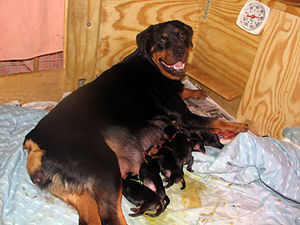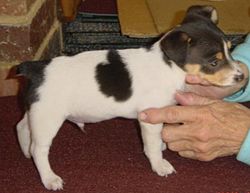Dog breeding: Difference between revisions
imported>Richard Pettitt (→References: references format) |
mNo edit summary |
||
| (6 intermediate revisions by 2 users not shown) | |||
| Line 1: | Line 1: | ||
{{subpages}} | {{subpages}} | ||
{{Image|IMG 0489z.jpg|right|300px|A Rottweiler dam in her whelping crate.}} | |||
'''Dog breeding''' is the vocation of mating carefully selected specimens of the same [[dog breed]] in order to reproduce specific, consistently replicable qualities and characteristics. | '''Dog breeding''' is the vocation of mating carefully selected specimens of the same [[dog breed]] in order to reproduce specific, consistently replicable qualities and characteristics. | ||
==History of dog breeding== | ==History of dog breeding== | ||
The relationship between humans and dogs is an ancient one. Cave paintings such as one found in | The relationship between humans and dogs is an ancient one. Cave paintings such as one found in [[Tassili-n-Ajjer]] suggest that primitive man and dog were already living in harmony. <ref> Ashworth, Lou Sawyer and Kraft, Irene. ''The Concise Encyclopedia of Dogs.'' London: Octopus Books, 1974. pgs. 79-81. (The site is referred to as ''Tessili''-n-Ajjer.)</ref> | ||
By the time of the pharaohs, dogs had already established their value as workers and human companions. Egyptian paintings show that [[selective breeding]] had already begun; [[sighthound]]s were clearly identified. Later, [[Pliny the Elder]] referred to the existence of--if not refined dog breeds, | By the time of the pharaohs, dogs had already established their value as workers and human companions. Egyptian paintings show that [[selective breeding]] had already begun; [[sighthound]]s were clearly identified. Later, [[Pliny the Elder]] referred to the existence of--if not refined dog breeds as we know them today, at least well-defined defined dog types. The Greeks and the Romans certainly bred dogs for specific, replicable qualities.<ref> Pliny the Elder, ''Natural History'' </ref> <ref> ''Concise Encyclopedia of Dogs'' contains illustrations of domestic dogs from a Minoan painting, circa 2000 B.C. and an Egyptian painting circa 1450 B.C., both depicting hounds, and an Assyrian relief depicting a mastiff type hunting dog in what appears to be a choke collar. </ref> | ||
By the medieval period, humans had realised that dogs could be selectively bred to pass on traits suited to the kinds of work they were expected to perform. There were | By the medieval period, humans had realised that dogs could be selectively bred to pass on traits suited to the kinds of work they were expected to perform. There were [[herding dog|herder]]s, guard dogs, cart pullers, hand and bed warmers, [[status symbol]]s, hunting hounds and [[terrier]]s; hunters had even classified dogs according to the type of game they were best suited to handle.<ref> Dame Juliana Berners ''The Boke of St Albans'' 1496 </ref>. There were restrictions on the size of dogs the underclasses could own, no non-noble hunters were likely among the earliest modern dog breeders. By the 16th Century, the first written work specifically and exclusively about dogs appeared <ref> Dr John Caius, ''Of Englische Dogges'': Dr Johannes Caius, De Canibus Brittanicus (1570) and translated by Abraham Fleming as ''Of Englishe Dogges'' (1576). .</ref> Dogs were used in sport and as vermin eradicators. | ||
The rise of [[fox hunting]] as a pleasure sport in the 17th & 18th Centuries exposed the need for a better hunting terrier. Indeed, the [[fox terrier]] would later become the first of the codified terrier breeds. <ref> Woolf, Norma Bennet''The Fox Terriers'' which can be found at: http://www.canismajor.com/dog/foxterr.html</ref> <ref> Curry, Aleta ''A Brief History of the Miniature Fox Terrier'' in Curry, Aleta, et. al (2006). Steward, Julienne, Ill. ''The 20th Anniversary Show Book: Twenty Years of the Mini Foxie Club of Australia''. ISBN 0-9758380-0-8. </ref> The less gentlemanly (but more accessible) sport of rat baiting also contributed to the selective breeding of small dogs. The continual refinement of dogs and dog breeds is clearly documented in western art. | |||
==Who is a dog breeder?== | ==Who is a dog breeder?== | ||
| Line 22: | Line 24: | ||
==Becoming a registered dog breeder== | ==Becoming a registered dog breeder== | ||
{{Image|Breeder checking Tri-colour male mini fox terrier puppy clip.jpg|left|250px|A responsible breeder examines every puppy for conformation and soundness/A Curry}}}} | |||
==Breeder qualifications== | ==Breeder qualifications== | ||
Requirements for the breeding of registered purebreds vary from club to club. Members may have to open their kennel facilities initially or periodically for inspection by the Registry, and/or pass tests to determine their breeding knowledge. | Requirements for the breeding of registered purebreds vary from club to club. Members may have to open their kennel facilities initially or periodically for inspection by the Registry, and/or pass tests to determine their breeding knowledge. | ||
| Line 44: | Line 46: | ||
<references/> | <references/> | ||
See also: [[Selective breeding]] | See also: [[Selective breeding]][[Category:Suggestion Bot Tag]] | ||
Latest revision as of 06:00, 8 August 2024
Dog breeding is the vocation of mating carefully selected specimens of the same dog breed in order to reproduce specific, consistently replicable qualities and characteristics.
History of dog breeding
The relationship between humans and dogs is an ancient one. Cave paintings such as one found in Tassili-n-Ajjer suggest that primitive man and dog were already living in harmony. [1] By the time of the pharaohs, dogs had already established their value as workers and human companions. Egyptian paintings show that selective breeding had already begun; sighthounds were clearly identified. Later, Pliny the Elder referred to the existence of--if not refined dog breeds as we know them today, at least well-defined defined dog types. The Greeks and the Romans certainly bred dogs for specific, replicable qualities.[2] [3]
By the medieval period, humans had realised that dogs could be selectively bred to pass on traits suited to the kinds of work they were expected to perform. There were herders, guard dogs, cart pullers, hand and bed warmers, status symbols, hunting hounds and terriers; hunters had even classified dogs according to the type of game they were best suited to handle.[4]. There were restrictions on the size of dogs the underclasses could own, no non-noble hunters were likely among the earliest modern dog breeders. By the 16th Century, the first written work specifically and exclusively about dogs appeared [5] Dogs were used in sport and as vermin eradicators.
The rise of fox hunting as a pleasure sport in the 17th & 18th Centuries exposed the need for a better hunting terrier. Indeed, the fox terrier would later become the first of the codified terrier breeds. [6] [7] The less gentlemanly (but more accessible) sport of rat baiting also contributed to the selective breeding of small dogs. The continual refinement of dogs and dog breeds is clearly documented in western art.
Who is a dog breeder?
Who is best qualified to be a dog breeder, and what constitutes proper dog breeding is at the core of many arguments in the hobby of dog fancy. Fanciers do tend to agree on what are not good reasons for dog breeding: providing a sex education experience for children, making money and experimental breeding top the list of disparaged motives.
At its best, breeding is a blend of science and art. The skilled breeder has at least general knowledge of dog genetics and health, and in-depth knowledge of the breed standard and conformation points of his chosen breed. Dog breeders agree that care for the development of the breed and concern for the health and wellbeing of each individual animal must be uppermost in a breeder’s motivation.
At worst, breeding can be a slip shod enterprise in which the major concern is profit, with little regard to the health and welfare of the dogs involved. These often take the form of so-called ‘backyard breeders’ (the term for random or ignorant breeding conducted on a small scale), and ‘puppy mills’ or ‘puppy farms’ (larger businesses). It must be pointed out, however, that many excellent breeders run small-scale programs in their homes, barns or back yards, and there are profitable large-scale business operations run with knowledgeable staff and superlative veterinary care, so size and motive alone are not indicative of the quality of the breeding program.
The birth of a litter of purebred puppies is recorded in a breed registry. These are maintained by organizations whose primary concern is securing the lineage records of the breed. Kennel clubs are one example of these, but such registries are not the exclusive province of show dogs, as is sometimes thought; the clubs of working dogs also maintain records of their dogs’ lineage.
Becoming a registered dog breeder
}}
Breeder qualifications
Requirements for the breeding of registered purebreds vary from club to club. Members may have to open their kennel facilities initially or periodically for inspection by the Registry, and/or pass tests to determine their breeding knowledge.
Brood stock qualifications
Most kennel clubs allow for any registered puppy to be bred from once it reaches a suitable age. Established breeder are sometimes conservative about selling entire animals for breeding, as poor issue may reflect badly on their kennels. Some clubs maintain an adjunct or limited register, for puppies of purebred parents not deemed to have the qualities for showing or breeding, or who exhibit a fault. A few breed clubs, such as the Swiss breed club of the Greater Swiss Mountain Dog, the Jack Russell Terrier Club of America and the Mini Foxie Club of Australia have additional, strict requirements for the certification of adult dogs before breeding.
With the advent of genetic testing, many registries are considering it advisable to test breeding dogs before mating, and some have made such tests mandatory. Among the genetically-transmitted conditions that can be screened are:
- Genetic blindness
- Genetic deafness
- Hip and/or elbow dysplasia
- Luxating patella
In addition to the reguirements of the registering authority, the owners of stud dogs and brood bitches may have their own conditions of mating. Kennels are said to be open (dogs standing at stud and bitches to be serviced by outside males) or closed, where no outside matings are allowed. These days, many owners with dogs "standing at stud" state that these are available "to approved bitches only", meaning that the stud owner will not allow mating with bitches deemed to be in any way undesirable.
A person wishing to start in dog breeding must therefore first learn about the breed and how to choose quality breeding animals, then they must find animals of good quality for sale that they can afford, and then find suitable mates. The process can be extremely time-consuming and there is a great deal of anecdotal evidence from new breeders finding it difficult to start in dog breeding due to the reluctance of established breeders to sell or share their stock.
References
- ↑ Ashworth, Lou Sawyer and Kraft, Irene. The Concise Encyclopedia of Dogs. London: Octopus Books, 1974. pgs. 79-81. (The site is referred to as Tessili-n-Ajjer.)
- ↑ Pliny the Elder, Natural History
- ↑ Concise Encyclopedia of Dogs contains illustrations of domestic dogs from a Minoan painting, circa 2000 B.C. and an Egyptian painting circa 1450 B.C., both depicting hounds, and an Assyrian relief depicting a mastiff type hunting dog in what appears to be a choke collar.
- ↑ Dame Juliana Berners The Boke of St Albans 1496
- ↑ Dr John Caius, Of Englische Dogges: Dr Johannes Caius, De Canibus Brittanicus (1570) and translated by Abraham Fleming as Of Englishe Dogges (1576). .
- ↑ Woolf, Norma BennetThe Fox Terriers which can be found at: http://www.canismajor.com/dog/foxterr.html
- ↑ Curry, Aleta A Brief History of the Miniature Fox Terrier in Curry, Aleta, et. al (2006). Steward, Julienne, Ill. The 20th Anniversary Show Book: Twenty Years of the Mini Foxie Club of Australia. ISBN 0-9758380-0-8.
See also: Selective breeding

